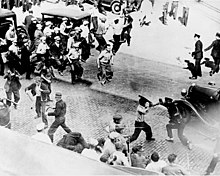
Back شغب Arabic Disturbiu AST Qiyam Azerbaijani Бунт Bulgarian Aldarull Catalan Nepokoje Czech Terfysg Welsh Aufruhr German Εξέγερση Greek Tumulto Esperanto


A riot or mob violence is a form of civil disorder commonly characterized by a group lashing out in a violent public disturbance against authority, property, or people.
Riots typically involve destruction of property, public or private. The property targeted varies depending on the riot and the inclinations of those involved. Targets can include shops, cars, restaurants, state-owned institutions, and religious buildings.[1]
Riots often occur in reaction to a grievance or out of dissent. Historically, riots have occurred due to poverty, unemployment, poor living conditions, governmental oppression, taxation or conscription, conflicts between ethnic groups (race riot) or religions (e.g., sectarian violence, pogrom), the outcome of a sporting event (e.g., sports riot, football hooliganism) or frustration with legal channels through which to air grievances.[2]
While individuals may attempt to lead or control a riot, riots typically consist of disorganized groups that are frequently "chaotic and exhibit herd behavior."[1] There is a growing body of evidence to suggest that riots are not irrational, herd-like behavior (sometimes called mob mentality), but actually follow inverted social norms.[3]
Dealing with riots is often a difficult task for police forces. They may use tear gas or CS gas to control rioters. Riot police may use less-than-lethal methods of control, such as shotguns that fire flexible baton rounds to injure or otherwise incapacitate rioters for easier arrest.[4]
- ^ a b Braha, D. (2012). "Global Civil Unrest: Contagion, Self-Organization, and Prediction". PLOS ONE. 7 (10): e48596. Bibcode:2012PLoSO...748596B. doi:10.1371/journal.pone.0048596. PMC 3485346. PMID 23119067.
- ^ Smead, Howard; Tager, Jack (December 2001). "Boston Riots: Three Centuries of Social Violence". The New England Quarterly. 74 (4): 669. doi:10.2307/3185445. ISSN 0028-4866. JSTOR 3185445.
- ^ "You won't prevent future riots by disregarding the psychology of crowds". The Guardian. Aug 19, 2011.
- ^ Davison, Neil (2009), "The Early History of 'Non-Lethal' Weapons", 'Non-Lethal' Weapons, Palgrave Macmillan UK, pp. 12–39, doi:10.1057/9780230233980_2, ISBN 978-1-349-30656-5
© MMXXIII Rich X Search. We shall prevail. All rights reserved. Rich X Search